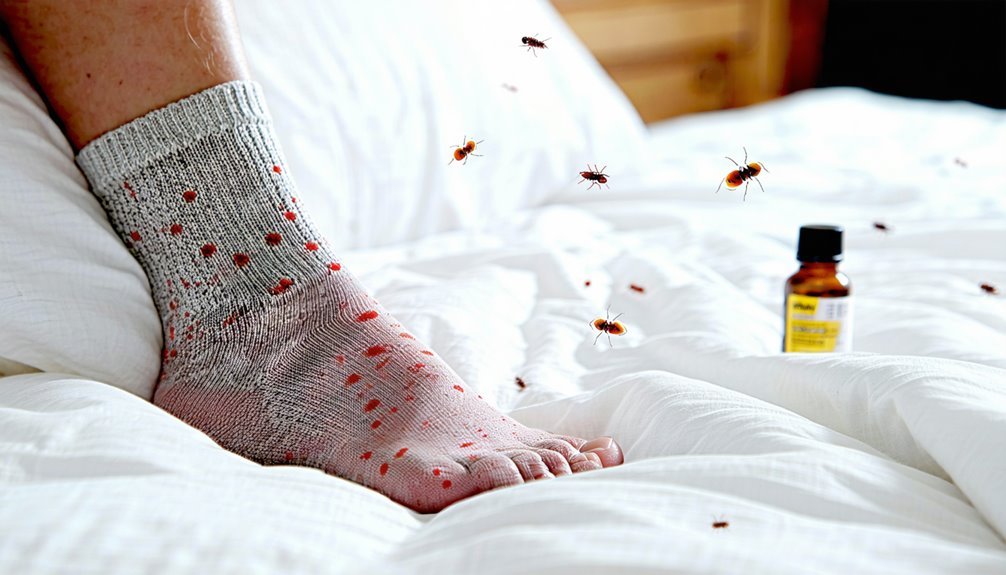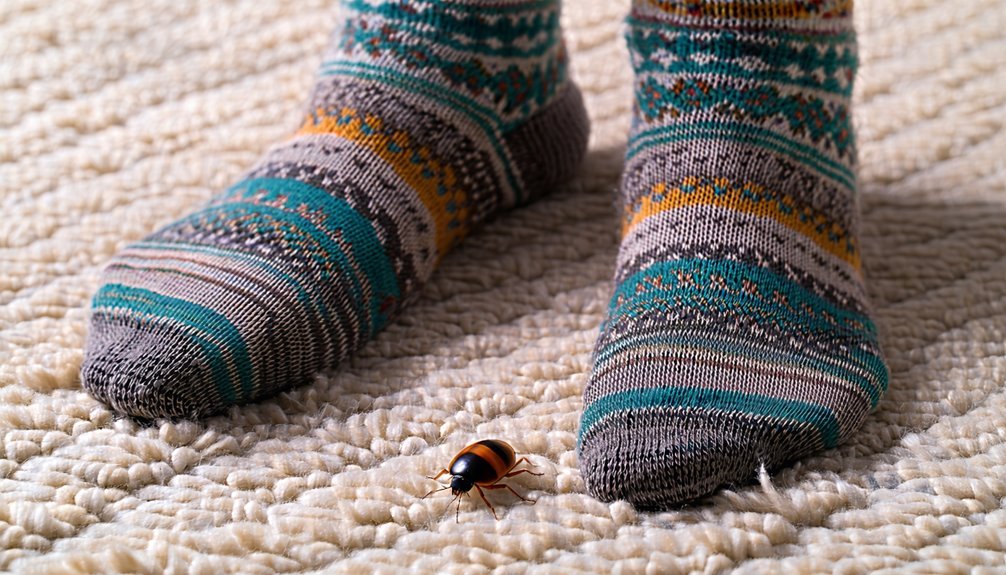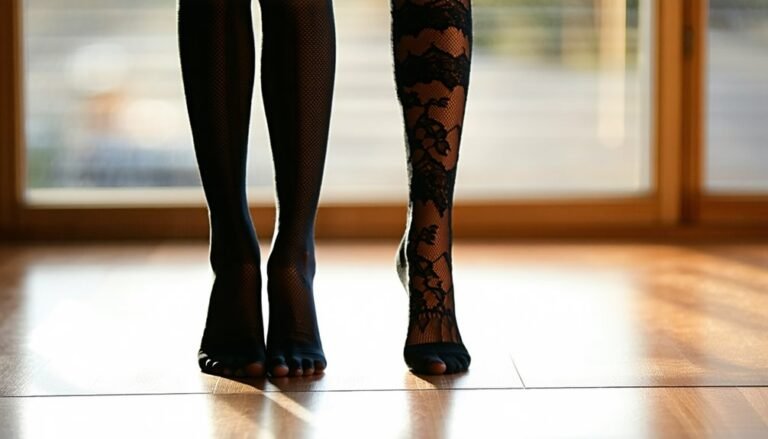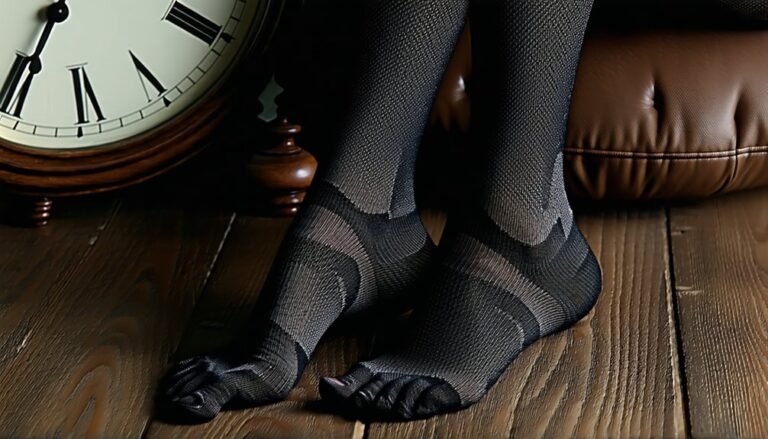Can Bed Bugs Bite Through Socks?
Bed bugs can't bite through socks, as their mouthparts can't penetrate dense fabrics. These insects identify hosts through heat and carbon dioxide and rely on thin, exposed skin rather than fabric-covered areas. Socks crafted from tightly woven materials create a barrier that bed bugs struggle to penetrate. Although socks provide protection, any gaps or exposed areas leave skin vulnerable. Discover more about enhancing your protection against these pests and effective prevention strategies.
Understanding Bed Bug Anatomy

Bed bugs, scientifically known as Cimex lectularius, possess a unique anatomy that enables their survival and proliferation in human environments. Their small, flat, oval bodies allow them to hide in the tiniest crevices, making detection and eradication challenging. Bed bug features include a segmented body and specialized mouthparts designed for piercing. Their exoskeleton is resilient, providing protection and flexibility for movement. Additionally, bed bugs have tiny, non-functional wings, indicating evolutionary adaptation to a parasitic lifestyle. Their sensory antennae are highly developed, enabling them to locate hosts through carbon dioxide and heat detection. Understanding bed bug anatomy is essential for implementing effective control measures, ensuring you can take necessary precautions to maintain a safe and secure environment, free from these persistent pests.
How Bed Bugs Feed
When examining the feeding process of bed bugs, you'll find it involves piercing the host's skin using specialized mouthparts called stylets. These insects are adept at detecting their blood source through the emission of carbon dioxide and body heat, enabling them to locate ideal feeding sites. Once attached, they inject anticoagulant compounds to facilitate a seamless blood meal.
Bed Bug Feeding Process
Though they are small and elusive, understanding how bed bugs feed is essential to addressing infestations effectively. Bed bug behavior involves a methodical feeding process. When they're ready to feed, these pests use elongated mouthparts to pierce the skin. The process involves injecting anticoagulants and anesthetics, reducing immediate bite reactions. This minimizes the likelihood of waking you, ensuring they can feed undisturbed for several minutes. Their feeding is primarily nocturnal, coinciding with periods when you're most vulnerable. The bites are often painless initially, but reactions can include itching and redness, appearing hours or days later. Recognizing these patterns of behavior aids in identifying potential infestations early, allowing you to take prompt action to safeguard your environment.
Blood Source Detection
Curiously, how do bed bugs manage to locate their blood source with such precision? You might be interested to know that these pests employ sophisticated blood detection mechanisms. Bed bugs utilize a combination of thermal and olfactory cues to identify their hosts. They can detect the carbon dioxide you exhale and the warmth your body emits, both signals essential for host identification. Their antennae play a significant role in sensing these indicators, allowing them to navigate towards the blood source even in total darkness. Once they've locked onto these cues, bed bugs can skillfully pierce the skin and access the blood vessels beneath. Understanding these methods helps you recognize potential risks and take effective measures to enhance your safety against these nocturnal feeders.
The Role of Clothing in Bed Bug Protection
While clothing might not be the first line of defense against bed bugs, it plays an important role in minimizing exposure and infestation risks. Different clothing types provide variable protection levels due to their material composition and weave density. For ideal safety, consider using tightly woven fabrics which create effective protective layers. These layers act as a barrier, reducing the likelihood of bed bugs reaching your skin. It's vital to maintain a well-fitted ensemble to minimize gaps, as loose clothing can inadvertently offer entry points. Additionally, covering exposed skin with layers, such as long sleeves and pants, enhances your defense strategy. By selecting appropriate clothing types, you're proactively mitigating potential threats posed by these pests, thereby contributing to a safer, more secure environment.
Can Bed Bugs Penetrate Fabric?
You might wonder if bed bugs can penetrate fabric, but it's essential to understand that their mouthparts have limitations that prevent them from doing so. The thickness of the fabric plays a significant role in providing a barrier against these pests, as thicker materials are less susceptible to penetration. To enhance protection, consider clothing materials specifically designed to prevent bed bug access, which often feature tightly woven or specialized protective properties.
Bed Bug Mouthparts Limitations
Though bed bugs are notorious for their ability to feed on human blood, their mouthparts have inherent limitations that prevent them from penetrating certain materials, such as fabric. Understanding bed bug anatomy is essential; their feeding mechanisms involve specialized mouthparts designed to pierce skin. These mouthparts, the stylets, are adapted for penetrating exposed surfaces rather than traversing the weave of fabrics. The stylets, encased in a protective sheath, are not robust enough to break through tightly woven textiles or dense materials. This limitation guarantees that standard clothing items, like socks, can provide a degree of protection. However, any gaps in fabric coverage may still leave you vulnerable, as bed bugs are adept at locating accessible skin areas to feed on.
Fabric Thickness Importance
Fabric thickness plays an essential role in determining whether bed bugs can penetrate a given material. The insects' mouthparts are adapted for piercing and sucking, but they face challenges with thicker textiles. When evaluating sock materials, it's vital to take into account fabric durability. Denser fabrics are less penetrable, providing enhanced protection against bites. Materials like tightly woven cotton or synthetic blends increase resistance by creating a barrier that's harder for bed bugs to breach. In contrast, thinner, loosely woven fabrics offer less defense. Understanding the relationship between fabric thickness and bed bug penetration helps you make informed decisions about your clothing choices. Prioritizing fabric durability in sock materials can greatly reduce the risk of bed bug bites, contributing to a safer environment.
Protective Clothing Materials
The role of fabric thickness in preventing bed bug penetration underscores the need to explore various protective clothing materials. Bed bugs typically struggle with thick, tightly woven fabrics. Not all clothing materials offer the same level of protection, so understanding their permeability is vital. Here's a comparative analysis of different protective fabrics:
| Fabric Type | Weave Density | Bed Bug Penetration Resistance |
|---|---|---|
| Denim | High | Very High |
| Nylon | Medium | Moderate |
| Silk | Low | Low |
As shown, denim, due to its high weave density, provides superior resistance to bed bug penetration compared to nylon or silk. When selecting clothing materials for protection, prioritize those with high weave density to enhance safety. Remember, effective protective fabrics are important in creating a barrier against these pests.
Tips for Keeping Bed Bugs at Bay

While understanding the persistence of bed bugs can be challenging, implementing effective strategies to prevent their infestation is fundamental. One of the primary methods involves utilizing bed bug traps. These devices can be strategically placed under bed legs to detect and capture bed bugs before they spread. Their design often includes a slippery surface that prevents escape, offering a proactive monitoring solution. Additionally, mattress encasements are essential in safeguarding your sleeping environment. By completely enclosing your mattress and box spring, these encasements create a physical barrier that inhibits bed bugs from establishing a harbor. They also facilitate easier identification of bed bug evidence, such as fecal spots. Regular inspection and maintenance of these protective measures are critical in maintaining a bed bug-free zone.
Effective Strategies for Bed Bug Prevention
Although preventing bed bug infestations may seem intimidating, incorporating a systematic approach can considerably reduce the risk. You must adopt preventive measures, focusing on both habitat management and pest control. Regularly inspect sleeping areas and maintain cleanliness to deter these pests. Enclosing mattresses in protective covers can impede bed bug access. Additionally, reducing clutter minimizes hiding spots, thereby enhancing control efforts. Consider integrating pest control strategies with professional assistance for extensive protection.
Implementing preventive measures can be visualized as follows:
| Step | Action | Outcome |
|---|---|---|
| Inspection | Regular check-ups | Early detection |
| Cleaning | Maintain hygiene | Reduced infestation risk |
| Enclosure | Use protective covers | Barrier against bed bugs |
| Decluttering | Minimize items | Limited hiding spaces |
| Professional | Consult experts | Enhanced pest control efficacy |
This structured approach enhances your safety.
Frequently Asked Questions
How Do Bed Bugs Spread From One Place to Another?
Bed bugs spread by hitchhiking on clothing, luggage, or furniture. Understanding bed bug behavior aids prevention; inspect items carefully, as these pests can infiltrate unnoticed. Prioritize vigilance and cleanliness to enhance safety and deter infestations effectively.
Do Bed Bugs Prefer Biting Certain Areas of the Body?
You might wonder about bed bugs' bite preferences. They often target exposed body areas, like your arms, neck, and face. This is due to accessibility, making it essential to cover these zones for enhanced safety.
Can Bed Bugs Transmit Diseases to Humans?
Like a storm in a teacup, bed bug bites rarely lead to disease transmission. Scientific studies suggest that these pests don't transmit diseases to humans, ensuring your health remains largely unaffected, though discomfort and allergic reactions may occur.
Are There Natural Remedies to Repel Bed Bugs Effectively?
You're curious about natural remedies to repel bed bugs. Essential oils like tea tree, lavender, and peppermint are popular natural repellents. While studies suggest effectiveness, they aren't foolproof. It's vital to combine these with other control methods for safety.
How Can I Identify a Bed Bug Infestation in My Home?
You might notice subtle whispers of bed bug signs, like tiny reddish stains on sheets, or ghostly pale skins. Infestation symptoms include itchy bites and musty odors. Inspect crevices, bed frames, and seams for these elusive critters. Stay vigilant.







